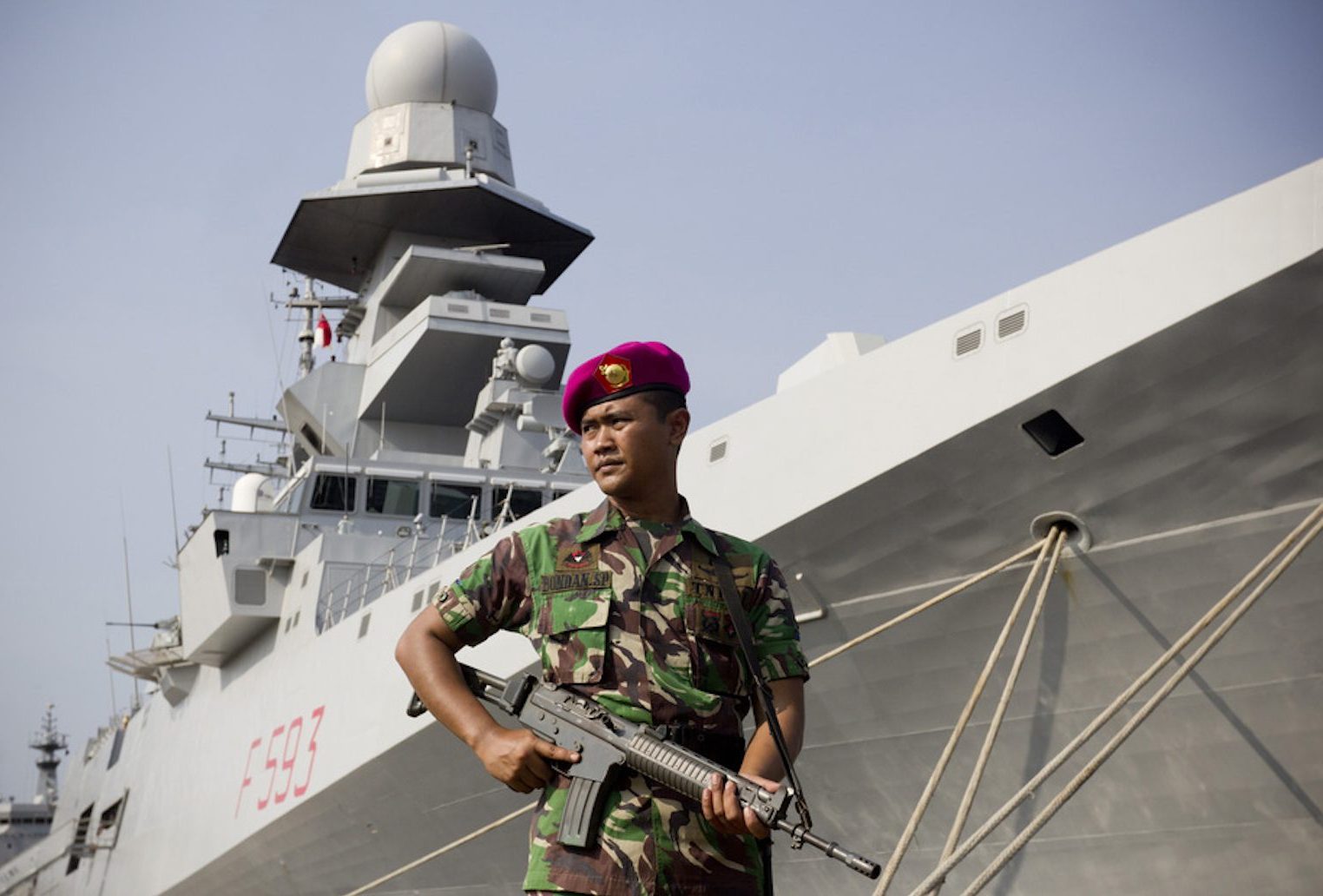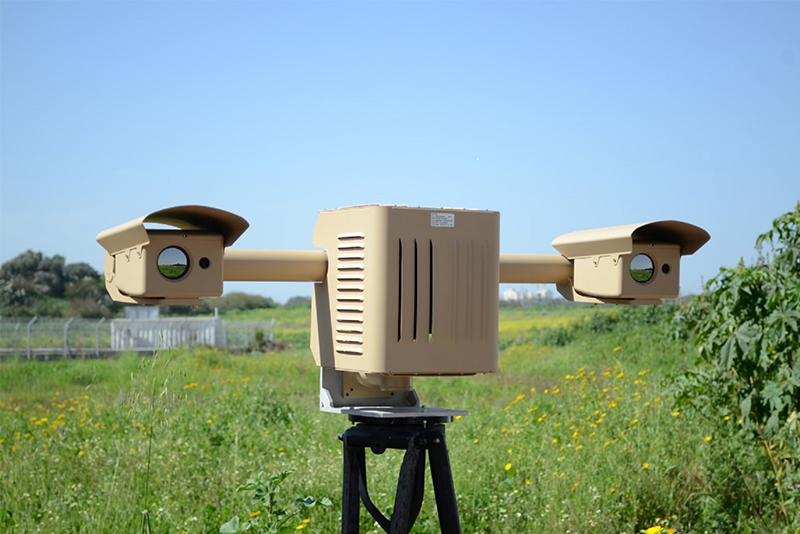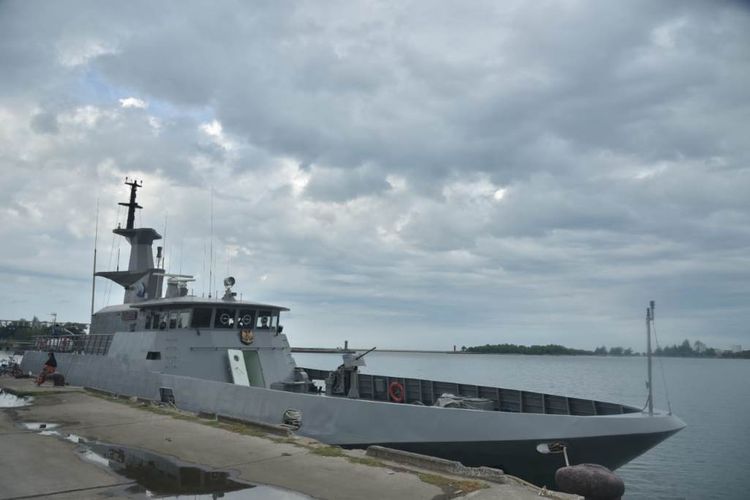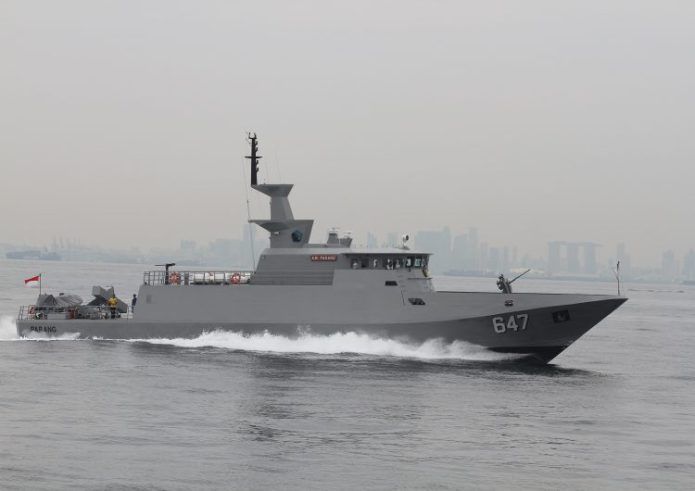
China, Indonesia sea dispute hot and getting hotter - Asia Times
JAKARTA - Chinese Coast Guard (CCG) cutter 5204 has become such a familiar sight inside and on the fringes of Indonesia’s 200-nautical-mile Economic
 asiatimes.com
asiatimes.com
China, Indonesia sea dispute hot and getting hotter
Jakarta issues diplomatic protest amid rising signs Beijing seeks to lay nine-dash line claim to parts of the North Natuna Sea
By JOHN MCBETH SEPTEMBER 15, 2020
An Indonesian officer on guard in front of a naval vessel in a file photo. Photo: Twitter
JAKARTA – Chinese Coast Guard (CCG) cutter 5204 has become such a familiar sight inside and on the fringes of Indonesia’s 200-nautical-mile Economic Exclusion Zone (EEZ) that it is now suspected of trying to stake out the limits of Beijing’s nine-dotted line of historically claimed sovereignty over the South China Sea.
The Indonesian government issued a formal protest to Chinese ambassador Xiao Qian over the latest intrusion on September 12, in which the Indonesian Maritime Security Agency (BAKAMLA) said the Chinese used the specific term “nine-dash line” in radio messages with an Indonesian patrol vessel.
While China recognizes Indonesian sovereignty over its northernmost Natuna archipelago, it has always refused to provide the exact coordinates of the nine-dash line, a broad tongue-shaped swathe of the South China Sea extending into the North Natuna Sea.
The latest incident suggests that Jakarta may sooner or later have to confront the fact that China is now seeking to lay down markers in claiming traditional fishing rights inside Indonesian waters in a clear breach of the 1982 United Nations Convention on the Law of the Sea (UNCLOS).
“In many locations, the CCG/People’s Liberation Army (PLA) Navy are trying to normalize the presence of their ships and then eventually move into enforcing their fishing rights and the nine-dash line,” says one naval analyst who requested anonymity.
Although not included among ships listed in the CCG fleet, 5204 is a 2,700-ton Zhaojun-Class cutter which normally plies between the Chinese-occupied Spratly islands and the Vanguard Bank, the westernmost reef of the disputed island group known for its oil and gas reserves.
Last January, it was also one of three Chinese cutters which intruded 100 kilometers into Indonesian waters in a large-scale incursion that caused Indonesia to scramble F-16 jets from Pekanbaru, southern Sumatra, and dispatch eight naval vessels to the scene.
Since then, the cutter is believed to have made several other intrusions after switching off its automatic identification system (AIS) for up to 36 hours as it ventured close to the maritime border, which lies about 70 kilometers south of Vanguard Bank.
The difference this time is it kept its transponder activated, which as the analyst explained, “means they want you to know.” It also took two days to return to international waters after it was intercepted by an Indonesian patrol vessel.
In its most forthright statement so far, Chinese Foreign Ministry spokesman told reporters at the height of the January stand-off: “Whether the Indonesian side accepts it or not, nothing will change the fact that China has rights and interests over the relevant waters.”
Some regional analysts believe China has stepped up it’s posturing more recently to counter what it sees as US President Donald Trump administration’s aggression, underlined by US naval deployments and hawkish statements from US Secretary of State Mike Pompeo.
Pompeo told last week’s East Asia Foreign Ministers summit that Beijing had no respect for democracy in the region and called on the region’s nations to fight Chinese domination and cut business ties with Chinese companies with interests in the South China Sea.
Speaking at the same online meeting, Chinese Foreign Minister Wang Yi denied that Beijing claimed all the waters within the nine-dash line as internal and territorial waters, calling it a “deliberate confusion of concepts and a distortion of China’s position.”
But he prefaced his statement by asserting that China has “sufficient historical and legal basis for its sovereignty and sovereign rights over the South China Sea,” claiming that under UNCLOS the “historic rights of countries should be respected.”
Four years ago, in a case brought by the Philippine government, an arbitral tribunal convened under a provision in the UNCLOS ruled that China has no legal basis to claim historic rights within its nine-dash line. Beijing rejected the ruling, which lacked an enforcement mechanism.
One noteworthy development was Wang’s support for “actively advancing” the long-delayed maritime Code of Conduct with the Association of Southeast Asian Nations (ASEAN), which aims to prevent armed clashes in the South China Sea.
“China persists in advocating ‘shelving disputes and developing together’ and is willing to pay attention to the energy needs of coastal countries under this framework and seek win-win and multi-win results,” he said.
Indonesian Foreign Minister Retno Marsudi used the East Asian conference to warn the US and China, as she has previously, not to involve Indonesia and its Southeast Asian neighbors in their competition in the South China Sea.
Coordinating Minister for Political Legal and Security Affairs Mahfud MD has said Indonesia will never be drawn into negotiations over its sovereign rights to waters north of the Natuna archipelago, which is part of the country’s Riau province.
Indonesian President Joko Widodo aboard a naval vessel in a file photo. Photo: Twitter/Presidential Handout
Marsudi and other senior officials also continue to insist there is no overlapping jurisdictions with China and that Indonesia has never recognized the nine-dash line, which first appeared in a map published by the Republic of China in 1947.
Unlike Malaysia and the Philippines, both claimants to the Spratly islands, Indonesia has taken a robust approach to protecting its maritime boundary with four Navy frigates and two Bakamla and Fisheries Ministry vessels patrolling the country’s northern approaches.
The Pekanbaru-based F-16s now conduct regular patrols over the Natunas. So do Boeing 737 and CN-235 maritime reconnaissance aircraft, flying out of Makassar in South Sulawesi, and a squadron of Israeli-made drones based in West Kalimantan.
@#comcom @Chestnut @Azull @T-123456












